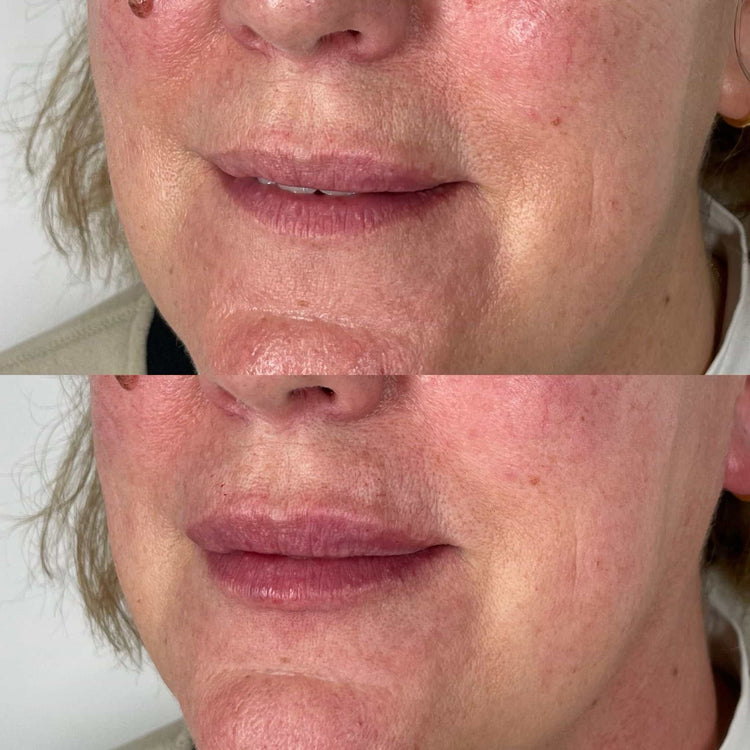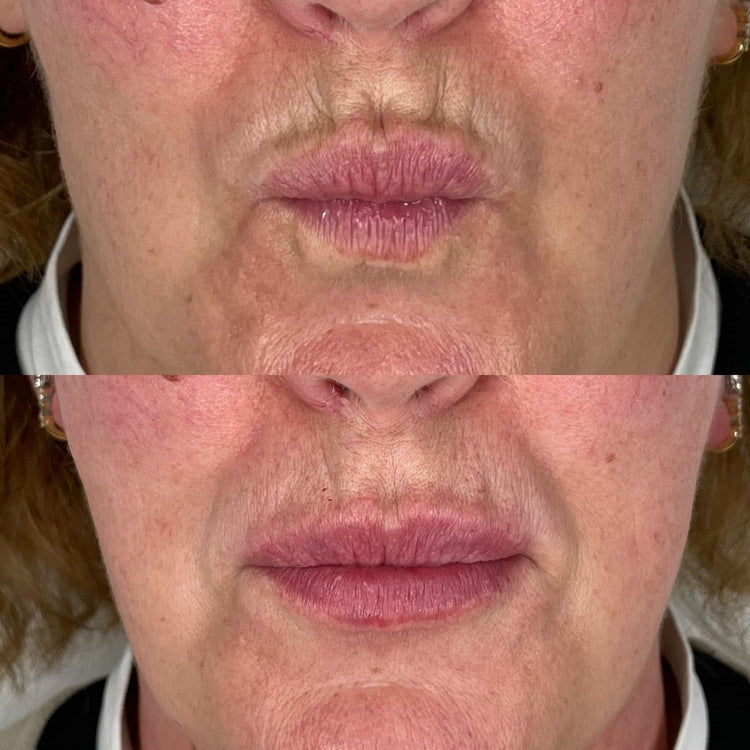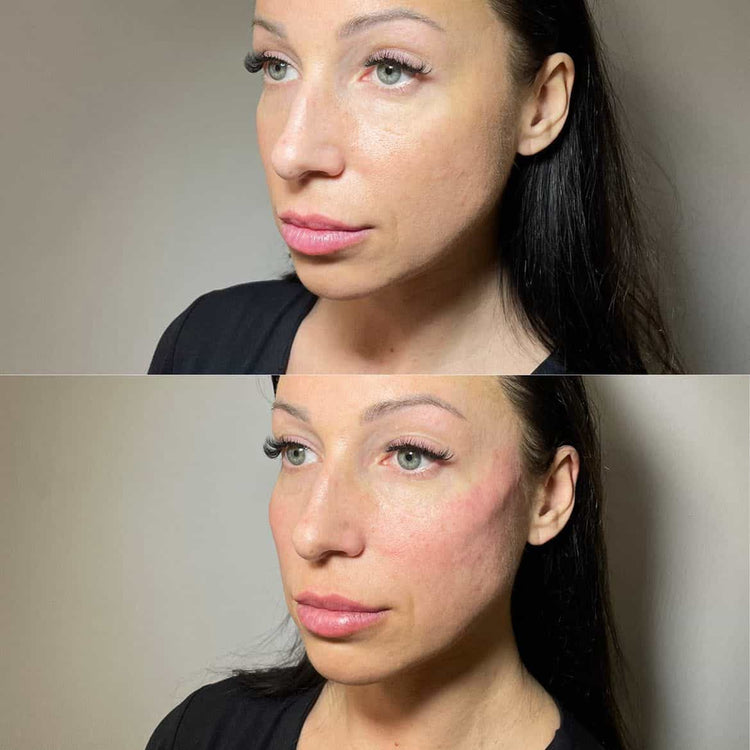Types of Dermal Fillers
Dermal fillers are injectables used to smooth wrinkles, plump up lips, and enhance facial features. These injectable gels are typically made from hyaluronic acid, a naturally occurring substance in the body that attracts and retains moisture. Other types of dermal fillers include poly-L-lactic acid (PLLA), calcium hydroxylapatite, and collagen.
Hyaluronic Acid-Based Fillers
Hyaluronic acid-based fillers are the most common type of dermal filler. They work by attracting and holding water molecules, which plumps up the skin and reduces the appearance of wrinkles and fine lines.
These fillers are typically made from a gel form of hyaluronic acid that is injected into the skin. Hyaluronic acid is a naturally occurring substance in the body, so it is well-tolerated and generally considered safe.
Collagen Fillers
Collagen fillers are another type of dermal filler that can help improve skin texture. Collagen is a protein found naturally in the skin that helps to provide structure and support. Over time, collagen production decreases, leading to wrinkles, sagging skin, and a loss of volume. Collagen fillers work by injecting synthetic collagen into the skin, helping to restore lost volume and smooth out wrinkles.
Collagen fillers are often used to treat areas such as the lips, cheeks, and hands.
Other Types of Fillers
Poly-L-lactic acid (PLLA) fillers stimulate collagen production in the skin, which can improve texture over time. These fillers are typically made from microspheres of PLLA that are injected into the skin. As the body absorbs the PLLA, it stimulates new collagen growth, leading to a gradual increase in volume and firmness.
Calcium hydroxylapatite (CaHA) fillers are another option. CaHA is a mineral that mimics the naturally occurring calcium found in bones. When injected into the skin, it provides immediate volume and can also stimulate collagen production over time.
How Dermal Fillers Improve Skin Texture
Dermal fillers offer a solution for individuals seeking smoother, more youthful-looking skin. These injectables work by plumping up areas of the face that have lost volume or contain wrinkles, leading to an overall improvement in skin texture.
Addressing Fine Lines and Wrinkles
Dermal fillers work to improve skin texture by replenishing lost volume and smoothing out fine lines and wrinkles. They achieve this through various mechanisms depending on their composition.
Hyaluronic acid-based fillers attract and retain water, effectively plumping up the skin and minimizing the appearance of wrinkles. Collagen fillers, on the other hand, directly replace lost collagen, providing structure and support to the skin, thereby reducing wrinkles and sagging.
Other types of fillers, such as poly-L-lactic acid (PLLA), stimulate the body’s natural collagen production, resulting in a gradual improvement in skin texture and volume over time. Calcium hydroxylapatite (CaHA) fillers offer both immediate volume restoration and long-term collagen stimulation.
Plumping the Skin
Dermal fillers are designed to address concerns about wrinkles, fine lines, and loss of volume in the face. They work by injecting gel-like substances under the skin, plumping it up and smoothing out imperfections.
Hyaluronic acid is a popular ingredient in dermal fillers because it naturally occurs in the body and attracts water molecules, effectively hydrating the skin and reducing the appearance of wrinkles.
Other types of fillers, like collagen and poly-L-lactic acid (PLLA), work by directly replacing lost collagen or stimulating the body’s own collagen production, leading to a firmer and smoother complexion over time.
The choice of filler depends on individual needs and desired outcomes.
Stimulating Collagen Production
Dermal fillers can significantly improve skin texture by replenishing lost volume and smoothing out fine lines and wrinkles. They achieve this through various mechanisms depending on their composition. Hyaluronic acid-based fillers, the most common type, work by attracting and retaining water molecules, plumping up the skin and minimizing the appearance of wrinkles.
Collagen fillers, on the other hand, directly replace lost collagen, providing structure and support to the skin, thereby reducing wrinkles and sagging. Poly-L-lactic acid (PLLA) fillers stimulate the body’s natural collagen production, leading to a gradual improvement in skin texture and volume over time. Calcium hydroxylapatite (CaHA) fillers offer both immediate volume restoration and long-term collagen stimulation.
Benefits of Using Dermal Fillers for Skin Texture Improvement
Dermal fillers have become increasingly popular as a non-surgical solution for improving skin texture. These injectable substances work by plumping up the skin, smoothing out wrinkles and fine lines, and restoring a more youthful appearance.
Improved Appearance and Self-Confidence
Dermal fillers offer a range of benefits for enhancing skin texture and overall facial appearance, often leading to increased self-confidence.
By replenishing lost volume and smoothing wrinkles, dermal fillers can create a smoother, more even complexion. This improvement in skin texture can contribute to a more youthful and radiant appearance.
Beyond physical changes, the positive impact on appearance can have a significant effect on self-esteem and confidence. Feeling good about one’s looks can lead to increased self-assurance and a more positive outlook.
Non-Surgical Solution
Dermal fillers provide several benefits for improving skin texture. They effectively plump up areas of the face that have lost volume, diminishing the appearance of wrinkles and fine lines.
By replenishing lost collagen and stimulating new collagen production, dermal fillers can improve skin firmness and elasticity, leading to a smoother and more youthful complexion.
These treatments offer a non-surgical solution for enhancing skin texture without the downtime and risks associated with surgical procedures.

Relatively Quick Procedure
Dermal fillers offer a solution for individuals seeking smoother, more youthful-looking skin. These injectables work by plumping up areas of the face that have lost volume or contain wrinkles, leading to an overall improvement in skin texture.
Dermal fillers work to improve skin texture by replenishing lost volume and smoothing out fine lines and wrinkles. They achieve this through various mechanisms depending on their composition.
Hyaluronic acid-based fillers attract and retain water, effectively plumping up the skin and minimizing the appearance of wrinkles. Collagen fillers, on the other hand, directly replace lost collagen, providing structure and support to the skin, thereby reducing wrinkles and sagging.

Other types of fillers, such as poly-L-lactic acid (PLLA), stimulate the body’s natural collagen production, resulting in a gradual improvement in skin texture and volume over time. Calcium hydroxylapatite (CaHA) fillers offer both immediate volume restoration and long-term collagen stimulation.
One of the key benefits of dermal fillers for skin texture improvement is their relatively quick procedure time.
Treatment sessions typically take only a few minutes to an hour, depending on the areas being treated and the type of filler used. Most patients can resume their normal activities immediately following the procedure, with minimal to no downtime required.
Risks and Side Effects
While dermal fillers offer promising results in improving skin texture, it is essential to be aware of potential risks and side effects associated with these procedures.
Temporary Side Effects (Swelling, Bruising)
Temporary side effects are common after dermal filler injections and typically resolve within a few days to weeks. These can include swelling, bruising, redness, tenderness, and itching at the injection site.
More serious but less common risks include allergic reactions, infection, and vascular occlusion (blockage of blood vessels).
Long-Term Risks (Lumping, Infection)
Long-term risks associated with dermal fillers are relatively uncommon but should be considered. One potential risk is “lumping,” which can occur if the filler is not properly distributed or if the body reacts to it in an unusual way. This can result in noticeable bumps or nodules under the skin.
Infection is another potential risk, though rare, and can occur at the injection site. Proper sterilization techniques are essential during the procedure to minimize this risk.
Choosing a Qualified Provider
When considering dermal fillers for skin texture improvement, choosing a qualified provider is paramount.
Experience and Expertise
Choosing a qualified provider is crucial when considering dermal fillers. Look for a licensed medical professional with extensive experience and expertise in injecting dermal fillers. Ask about their training, certifications, and the number of procedures they have performed.
It’s also important to inquire about the specific types of fillers they use and their recommendations based on your individual needs and skin type.
Reputation and Reviews
Choosing a qualified provider is crucial when considering dermal fillers. Look for a licensed medical professional with extensive experience and expertise in injecting dermal fillers.
Ask about their training, certifications, and the number of procedures they have performed. It’s also important to inquire about the specific types of fillers they use and their recommendations based on your individual needs and skin type.

Reading reviews and testimonials from previous patients can provide valuable insights into a provider’s skills and patient satisfaction.
Pay attention to both positive and negative feedback, as this can give you a more balanced perspective.
Check for online reviews on platforms such as Google, Yelp, or specialized medical review websites.
Consultation and Treatment Plan
Choosing a qualified provider is crucial when considering dermal fillers. Look for a licensed medical professional with extensive experience and expertise in injecting dermal fillers. Ask about their training, certifications, and the number of procedures they have performed. It’s also important to inquire about the specific types of fillers they use and their recommendations based on your individual needs and skin type.
Reading reviews and testimonials from previous patients can provide valuable insights into a provider’s skills and patient satisfaction. Pay attention to both positive and negative feedback, as this can give you a more balanced perspective. Check for online reviews on platforms such as Google, Yelp, or specialized medical review websites.
During your consultation, be sure to discuss your aesthetic goals, medical history, and any medications or allergies you have. Your provider should thoroughly examine your skin and explain the procedure in detail, including potential risks and benefits. They will also recommend a personalized treatment plan based on your individual needs and desired outcomes.
Maintenance and Aftercare
Proper maintenance and aftercare are essential for maximizing the results of dermal filler treatments and ensuring long-lasting improvements to skin texture.
Follow-Up Appointments
To maintain optimal results from dermal fillers, it’s important to follow your provider’s instructions carefully.
They will likely advise you on certain lifestyle adjustments, such as avoiding excessive sun exposure and using sunscreen daily to protect the treated area from further damage.
Certain activities that could increase pressure or trauma to the treated area, like strenuous exercise or massage, may also need to be limited for a specific period.
Follow-up appointments are crucial for monitoring the results of dermal filler treatment and ensuring your satisfaction.
Your provider will schedule follow-up appointments at appropriate intervals to assess how the fillers are settling, check for any potential side effects or complications, and determine if additional treatments are needed.
During these appointments, you can discuss any concerns you may have about the treatment or your results.
This open communication allows your provider to make adjustments or recommendations to optimize your treatment plan and achieve your desired aesthetic goals.
Sun Protection
Proper maintenance and aftercare are crucial for maximizing the results of dermal filler treatments and ensuring long-lasting improvements to skin texture.
To maintain optimal results from dermal fillers, it’s important to follow your provider’s instructions carefully. They will likely advise you on certain lifestyle adjustments, such as avoiding excessive sun exposure and using sunscreen daily to protect the treated area from further damage. Certain activities that could increase pressure or trauma to the treated area, like strenuous exercise or massage, may also need to be limited for a specific period.
Follow-up appointments are crucial for monitoring the results of dermal filler treatment and ensuring your satisfaction. Your provider will schedule follow-up appointments at appropriate intervals to assess how the fillers are settling, check for any potential side effects or complications, and determine if additional treatments are needed.
During these appointments, you can discuss any concerns you may have about the treatment or your results. This open communication allows your provider to make adjustments or recommendations to optimize your treatment plan and achieve your desired aesthetic goals.
Sun protection is crucial for maintaining the longevity and effectiveness of dermal fillers. The sun’s ultraviolet (UV) rays can break down hyaluronic acid, a common component in many dermal fillers, leading to a faster breakdown and loss of volume over time.
It’s essential to wear broad-spectrum sunscreen with an SPF of 30 or higher daily, even on cloudy days, to protect your skin from the sun’s harmful rays.
When exposed to UV radiation, hyaluronic acid degrades more quickly, resulting in a shorter lifespan for dermal fillers.
Wearing sunscreen helps preserve the effects of the filler and maintain the desired results for a longer period.
Lifestyle Modifications
Proper maintenance and aftercare are crucial for maximizing the results of dermal filler treatments and ensuring long-lasting improvements to skin texture.
- Follow your provider’s instructions carefully regarding lifestyle adjustments such as avoiding excessive sun exposure and using sunscreen daily.
- Limit activities that could increase pressure or trauma to the treated area, like strenuous exercise or massage, for a specified period.
- Attend all scheduled follow-up appointments to monitor the results, address any concerns, and ensure optimal treatment outcomes.
Discover the best dermal filler options for your needs at It’s Me & You Clinic
